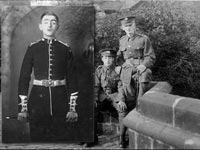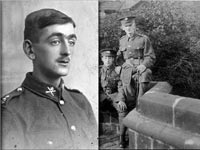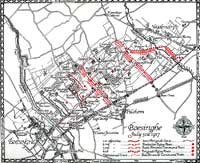
'THE GREAT WAR', 'THE WAR TO END WAR', 'WORLD WAR 1'
1914 - 1918
 |
EDWARD GARSIDE WHITEHEAD Guardsman 21718, 4th BATTALION GRENADIER GUARDS: Service No. 385 GUARDS MACHINE-GUN CORPS No. 2 Company Killed in Action 31st July 1917 3rd Battle of Ypres (Passchendaele) |
 |
With many page transcriptions from 'The Grenadier Guards in the Great War of 1914-1918' by Sir Frederick Ponsonby, to recount the actual organisation & battles in which the Grenadiers, in particular the 4th Battalion, took part. Pub. 1920 in 3 Volumes, . from Volume 2 |
|||||||||||||||||||||||
Chapter XXIII Boesinghe July 31 1917 |
~~~~~~~~~~~~~~~~~~~~~~~~~~~~~~~~~~~~~~~~~~~~~~~~~~~~~~~~~~~~~~~ p. 199 CHAPTER XXIII DURING this month the Germans made a determined attack on Nieuport in thc Dune country near the coast, and succeeded in penetrating 600 yards into the British line, in spite of the stout resistance of the British troops; but a counter-attack was successfully launched, and restored the line to its original position. At the end of July a combined attack by the British and French troops in Flanders commenced in thc neighbourhood of Ypres. On the French front the Germans made strong attacks on the Chemin des Dames and gained some ground after severe fighting, but a week later the French were able to regain all the lost ground. The Russians, under General Korniloff, advanced in Galicia, and even gained some victories over the Austrians, but disaffection was beginning to show itself among the men, and thc Germans found no difficulty in driving them back over the frontier. This retirement on the part of the Russians ended in an ignominious retreat and open mutiny. London was raided by a large number of German aeroplanes, and many people were killed and wounded by the bombs which were dropped. |
||||||||||||||||||||||
The Guards Div Boesinghe July 1917 |
~~~~~~~~~~~~~~~~~~~~~~~~~~~~~~~~~~~~~~~~~~~~~~~~~~~~~~~~~~~~~~~ p. 200 THE GUARDS DIVISION When the attack on the Boesinghe Sector was decided upon, the great difliculty of crossing the Canal under the enemy's artillery fire at once presented itself to the Corps and Divisional Commanders. It would be necessary to con struct bridges, and under an accurate barrage the loss of life entailed in crossing the Canal would certainly be very heavy. Lord Cavan thoroughly appreciated the drawbacks, but thought a well-organised attack would succeed. He ordered every detail of the attack to be carefully rehearsed over dummy representations of the Canal and the German trenches, and by the end of July every officer, N.C.O., and even every man knew exactly what he had to do. During this time the enemy seem to have been completely ignorant of the preparations that were being made, and imagined that so long as their positions farther` south remained intact there was small probability of an attack on this sector of the line. The date of the attack, or zero day, was originally fixed for the 28th, but on the 24th it was postponed until the 31st. About a week before zero day British aeroplanes reported that, although the German trenches were fully manned at dawn, the greater part of the garrison was withdrawn during the day to avoid the shells. |
||||||||||||||||||||||
The Guards Div Boesinghe July 1917 |
~~~~~~~~~~~~~~~~~~~~~~~~~~~~~~~~~~~~~~~~~~~~~~~~~~~~~~~~~~~~~~~ p. 201-202 A small incident occurred which left no doubt in General Feilding's mind on this point. Two wounded British soldiers who had been left behind during a night raid were observed on the far side of the Canal, and Lieutenant C.J. Hambro and Private Smith of the 3rd Battalion Coldstream Guards volunteered to go across the Canal and bring them in. This they succeeded in doing, and Lieutenant Hambro reported that not only had he not been fired on during his successful venture, but that he had seen no signs of the enemy at all. General Feilding thereupon conceived the audacious plan of seizing the Canal in broad daylight without the aid of an artillery barrage. If the information which he had gained was correct, the enterprise would certainly succeed, but if on the other hand the absence of the Germans was only momentary, as had so often happened, it might prove a costly failure. He decided not to wait but to strike at once, and accordingly sent for Lieut.-Colonel Crawford commanding the 3rd Battalion Coldstream Guards, and told him to send out strong patrols properly supported at 5pm as far as Baboon Support Trench, Artillery Wood, and Cactus Junction. As the matter was urgent, these orders were given verbally, and were later confirmed in writing, but it was not found possible to start before 5.20. The whole scheme, although planned at a moment's notice, was well thought out. The patrols pushed forward closely followed by supporting platoons and moppers-up, and succeeded without difficulty in reaching their objectives, where they surprised the Germans who had been left in charge of the trenches. Many prisoners were made, but so quickly and unobtrusivcly was the raid carried out that the Germans in rear were totally ignorant of what was happening in front. The Division on the right attempted a similar raid somewhat later, but owing to no moppers-up having been ordered to accompany the raiders, the patrols were captured or killed by Germans who emerged from dug-outs in rear of them. The following day, however, it succeeded in gaining a foothold on the farther bank of the Canal. For the best part of two days the 3rd Battalion Coldstream Guards remained in its advanced positions unmolested. Wlien the men of a German patrol advanced on their usual rounds, they were allowed to enter the trench, and were then quietly made prisoners. On the 29th another patrol sauntered along down a communication trench quite unconscious of the danger it was approaching; the officer himself and the leading men were made prisoners, but the N.C.O. in rear escaped, although he was fired upon. Presumably he dashed off, and telephoned that the front German trenches were in our hands. It was not long before enemy aeroplanes came soaring over at a comparatively low height to investigate the situation, and then the enemy's artillery deluged these trenches unmercifully with shells. |
||||||||||||||||||||||
The Guards Div Boesinghe July 29-30 1917 |
~~~~~~~~~~~~~~~~~~~~~~~~~~~~~~~~~~~~~~~~~~~~~~~~~~~~~~~~~~~~~~~ p. 203-204
The first objective, or Blue line, consisted of Cariboo Trench, Wood 15 Trench, and Wood 15. The French First Division was on the left, and the thirty-eighth Welsh Division on the right of the Guards Division. The 2nd and 3rd Guards Brigades were to take the first three objectives, and the 1st Guards Brigade was then to pass through and secure the fourth. In the 2nd and 3rd Brigades the leading Battalions were responsible for the first and second objectives, and the Battalions in support for the third. So carefully had the whole attack been rehearsed that from the first there was never a moment's hesitation: each Company knew exactly what was expected of it. If General Feilding with his staff had thought out every eventuality, he could not have asked for more prompt execution of his orders. Each successive objective was captured exactly according to the time stated in the orders. The creeping barrage was perfect. The Field Companies of the Royal Engineers did admirable work, and nothing could have been better than the arrangements for bringing up ammunition, water, and rations. There appears to have been no hitch throughout the attack. Ponsonby's Brigade on the right occupied the frontage from the railway to Boesinghe Bridge, while Seymour's Brigade continued the line to the left for 600 yards. The frontage of Ponsonby's Brigade, although much smaller than that of Seymour's, included more enclosed and difficult country with many strong points. |
||||||||||||||||||||||
The Guards Div Boesinghe July 30-31 1917 |
~~~~~~~~~~~~~~~~~~~~~~~~~~~~~~~~~~~~~~~~~~~~~~~~~~~~~~~~~~~~~~~ p. 205-206 Whether it was wise to have the railway as a boundary between the Guards and the Thirty-eighth Division is open to doubt. There was a number of concrete block-houses on the railway which gave a great deal of trouble, and required the united efforts of the troops on the flanks of both Divisions. Now the junction of two Divisions is admittedly the weakest part in the line, and therefore it would have been better had the difficult task of capturing these block-houses been entrusted wholly to one Division. These concrete block-houses or "pill-boxes" were built in the ruins of the numerous farms scattered about the country. They were cunningly concealed under old roofs and screened from frontal view by bricks and rubble, and the tops were often covered with old tiles, grass, or earth. They were generally built to accommodate eight or twelve men, and were strong enough to resist a direct hit from a field-gun or light howitzer, but their weakness seems to have been the restricted field of fire from the loopholes. This enabled troops to work round them and often close up to them without difficulty. The morning was excessively dark and cloudy, although it was not raining. Zero hour was at 3.50, but it was not until 4.10am that the 2nd Battalion Irish Guards and 1st Battalion Scots Guards advanced in four waves, with an interval of 100 yards between each wave, moving at the rate of 100 yards in four minutes behind the creeping barrage. The first objective was captured at 4.30. During the barrage which the enemy's artillery put down on the Canal, the Scots Guards had the misfortune to lose the services of their Commanding Officer, Lieut.-Colonel Romilly, who was wounded by a shell, and soon after the attack started Lieut.-Colonel E.B. Greer commanding the 2nd Battalion Irish Guards was killed. This was a serious loss to the Guards Division, as he had proved himself a most able officer. Punctually the attack on the second objective started, and although the pill-boxes proved hard nuts to crack, the Black line was successfully taken. The Scots Guards had their right flank constantly exposed to enfilade fire from the railway, and were consequently obliged to throw back a defensive flank, so that when they reached the Black line they had hardly sufficient men for the front allotted to them. The 3rd Battalion Grenadiers and 1st Battalion Coldstream in support, however, made good the deficiency when they advanced to the third objective. The 3rd Battalion Grenadiers which passed through the Scots Guards had to contend with precisely the same difficulty, and as it advanced was continually obliged to leave men to guard its right flank. In spite of all this, the Green line fell into our hands, and was at once consolidated. |
||||||||||||||||||||||
The Guards Div Boesinghe July 31 1917 |
~~~~~~~~~~~~~~~~~~~~~~~~~~~~~~~~~~~~~~~~~~~~~~~~~~~~~~~~~~~~~~~ p. 207-208 Meanwhile the 1st Battalion Grenadiers and 1st Battalion Welsh Guards in Seymour's Brigade had the advantage of starting the attack from Baboon Reserve Trench some 500 yards on the far side of the Canal, and had to wait some time to enable Ponsonby's Brigade to come up on their right. They advanced behind the creeping barrage and had no difficulty in reaching the first objective. Nor did the Black line present any great stumbling-block, although the casualties here were heavier. As soon as this line was consolidated, the 4th Battalion Grenadiers and 2nd Battalion Scots Guards passed through and attacked the Green line. Here there was a slight delay, as the French Division on the left was held up near Colonel's Farm. It was only a momentary check, and as the 2nd Battalion Scots Guards passed this farm the French were able to capture it. So the Green line was reached. The moment had now arrived for Jeffrey's Brigade to pass through, and the 2nd Battalion Grenadiers on the right, and the 2nd Battalion Coldstream on the left, taking up the whole Divisional frontage, swept over the ground in perfect formation. The task of the Grenadiers involved the more severe fighting, since they were confronted with a large number of "pill-boxes." They also had the same difficulty as their predecessors with the railway, but after severe fighting succeeded in one place in gaining a foothold on the farther side of the Steenbeek River. No. 2 Company of the 2nd Grenadiers, on the extreme right, reached the river, but found it impossible to cross it. Although the Coldstream did not encounter so much opposition, they had to wheel to the left in the course of the advance - by no means an easy manoeuvre when the shells were falling thick; but they carried out their task most successfully, and joined up with the Grenadiers, By 11am Brigadier-General Jeffreys was able to report that, except by the extreme right Company, all the objectives had been secured. No counter-attack was attempted against the front held by the Guards Division, no doubt because the Germans were thoroughly disorganised. At the end of the attack our barrage became thin and uncertain, making it impossible for the companies in front to send out patrols; but when it became dark the barrage ceased, and the 2nd Battalion Coldstream Guards succeeded in establishing advanced posts at Pinson and Sentier Farms. During the advance the dash and gallantry displayed by the 201st French Regiment on the left, often in circumstances of exceptional difficulty, gained the admiration of the whole Guards Division. The ground over which it passed was covered with block-houses; there were several strong posts which had to be reckoned with; but in spite of all this it managed to keep pace with the Division. The total casualties in the Guards Division during these operations were 59 officers and 1876 men, while 750 Germans were taken prisoner, and 30 machine- guns and 1 howitzer were captured. ~~~~~~~~~~~~~~~~~~~~~~~~~~~~~~~~~~~~~~~~~~~ Next part |
||||||||||||||||||||||
Part 1 * Edward enlists in Jan.1915; Transcripts: * formation of the 4th Battn. * Guards Division in 1915. |
|||
Part 4 Edward lands in France Oct. Transcripts: * Diary of the War- Oct., Nov., Dec., 1915; * 4th Battn. Oct - Dec |
Part 5 Edward transfers to Machine-Gun Guards Transcripts: * Diary of the War - Jan - Sept. 1916; * 4th Battn. Jan - Apr. 1916 |
||
Part 9 Transcripts: * Diary of the War - Oct to Dec 1916: * 4th Battn - Oct - Nov 1916; * Diary of the War - Jan - Mar 1917; * 4th Battn. Jan - Mar 1917 |
|||
Part 12 Transcripts: * Edward Killed in action in Battle of Boesinghe 31 July 1917 *3rd Battalion - Boesinghe 1st battalion - Boesinghe 4th battalion - Boesinghe |
Part 13
|
* Gallery of pictures & Maps |
|
'The Grenadier Guards in the Great War of 1914-1918' by Sir Frederick Ponsonby Pub. 1920 in 3 Volumes, is freely downloadable as .pdf files or can be read on-line. |
|||
Vol 1 HERE |
Vol 2 HERE |
Vol 3 HERE |
|
Contributed by Sheila Goodyear
World War 1 Project MENU PAGE |
Members' Pages MENU |
